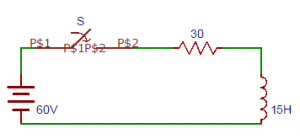This set of Network Theory Multiple Choice Questions & Answers (MCQs) focuses on “DC Response of an R-L Circuit”.
1. The expression of current in R-L circuit is?
a) i=(V/R)(1+exp((R/L)t))
b) i=-(V/R)(1-exp((R/L)t))
c) i=-(V/R)(1+exp((R/L)t))
d) i=(V/R)(1-exp((R/L)t))
View Answer
Explanation: The expression of current in R-L circuit is i = (V/R)-(V/R)exp((R/L)t). On solving we get i = (V/R)(1-exp((R/L)t)).
2. The steady state part in the expression of current in the R-L circuit is?
a) (V/R)(exp((R/L)t))
b) (V/R)(-exp((R/L)t))
c) V/R
d) R/V
View Answer
Explanation: The steady state part in the expression of current in the R-L circuit is steady state part = V/R. When the switch S is closed, the response reaches a steady state value after a time interval.
3. In the expression of current in the R-L circuit the transient part is?
a) R/V
b) (V/R)(-exp((R/L)t))
c) (V/R)(exp((R/L)t))
d) V/R
View Answer
Explanation: The expression of current in the R-L circuit has the transient part as
(V/R)(-exp((R/L)t)). The transition period is defined as the time taken for the current to reach its final or steady state value from its initial value.
4. The value of the time constant in the R-L circuit is?
a) L/R
b) R/L
c) R
d) L
View Answer
Explanation: The time constant of a function (V/R)e-(R/L)t is the time at which the exponent of e is unity where e is the base of the natural logarithms. The term L/R is called the time constant and is denoted by ‘τ’.
5. After how many time constants, the transient part reaches more than 99 percent of its final value?
a) 2
b) 3
c) 4
d) 5
View Answer
Explanation: After five time constants, the transient part of the response reaches more than 99 percent of its final value.
6. A series R-L circuit with R = 30Ω and L = 15H has a constant voltage V = 60V applied at t = 0 as shown in the figure. Determine the current (A) in the circuit at t = 0+.

a) 1
b) 2
c) 3
d) 0
View Answer
Explanation: Since the inductor never allows sudden changes in currents. At t = 0+ that just after the initial state the current in the circuit is zero.
7. The expression of current obtained from the circuit in terms of differentiation from the circuit shown below?

a) di/dt+i=4
b) di/dt+2i=0
c) di/dt+2i=4
d) di/dt-2i=4
View Answer
Explanation: Let the i be the current flowing through the circuit. By applying Kirchhoff’s voltage law, we get 15 di/dt+30i=60 => di/dt+2i=4.
8. The expression of current from the circuit shown below is?

a) i=2(1-e-2t)A
b) i=2(1+e-2t)A
c) i=2(1+e2t)A
d) i=2(1+e2t)A
View Answer
Explanation: At t = 0+ the current in the circuit is zero. Therefore at t = 0+, i = 0 => 0 = c + 2 =>c = -2. Substituting the value of ‘c’ in the current equation, we have i = 2(1-e-2t)A.
9. The expression of voltage across resistor in the circuit shown below is?

a) VR = 60(1+e2t)V
b) VR = 60(1-e-2t)V
c) VR = 60(1-e2t)V
d) VR = 60(1+e-2t)V
View Answer
Explanation: Voltage across the resistor VR = iR. On substituting the expression of current we get voltage across resistor = (2(1-e-2t))×30=60(1-e-2t)V.
10. Determine the voltage across the inductor in the circuit shown below is?

a) VL = 60(-e-2t)V
b) VL = 60(e2t)V
c) VL = 60(e-2t)V
d) VL = 60(-e2t)V
View Answer
Explanation: Voltage across the inductor VL = Ldi/dt. On substituting the expression of current we get voltage across the inductor = 15×(d/dt)(2(1-e-2t)))=60(e-2t)V.
Sanfoundry Global Education & Learning Series – Network Theory.
To practice all areas of Network Theory, here is complete set of 1000+ Multiple Choice Questions and Answers.
If you find a mistake in question / option / answer, kindly take a screenshot and email to [email protected]
